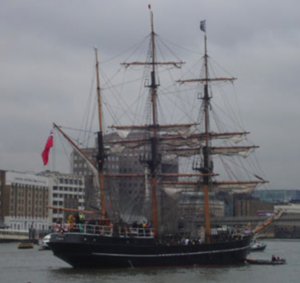 Beginning on 29 November 1781, at least 132 slaves were thrown overboard from the slave-ship The Zong (replica, pictured left) into the seas off Jamaica. In Gregson v Gilbert (1783) 3 Doug 232, 99 ER 629, [1783] EngR 85 (22 May 1783) (pdf)) the owners argued that this had been done to preserve drinking water for the crew, and they sought to recover the value of the slaves from their insurers. It is voyage 84106 on the Trans-Atlantic Slave Trade Database. An excellent account of the circumstances is provided by Trevor Burnard “A New Look at the Zong Case of 1783” (2019) 76 XVII-XVIII [En ligne].
Beginning on 29 November 1781, at least 132 slaves were thrown overboard from the slave-ship The Zong (replica, pictured left) into the seas off Jamaica. In Gregson v Gilbert (1783) 3 Doug 232, 99 ER 629, [1783] EngR 85 (22 May 1783) (pdf)) the owners argued that this had been done to preserve drinking water for the crew, and they sought to recover the value of the slaves from their insurers. It is voyage 84106 on the Trans-Atlantic Slave Trade Database. An excellent account of the circumstances is provided by Trevor Burnard “A New Look at the Zong Case of 1783” (2019) 76 XVII-XVIII [En ligne].
This infamous massacre featured on last Thursday’s episode of In Our Time on BBC Radio 4 (podcast via BBC Sounds | Apple | Spotify). Vincent Brown (Harvard University), Bronwen Everill (University of Cambridge), and Jake Subryan Richards (London School of Economics), joined long-time host Melvyn Bragg in a powerful hour or so of difficult but necessary listening.
In previous posts on this blog, I have looked at the case through the lens of Simon Schama’s history Rough Crossings, William Turner’s painting The Slave Ship, and M. NourbeSe Philip’s poetry cycle The Zong! (tune in via here for the next 10 days). In the Turner post, I also looked at how The Zong influenced an episode of a popular BBC television courtroom drama, Garrow’s Law. Since then, it has been given a role in a Hollywood movie. Belle (imdb | movie site | wikipedia) concerns Dido Elizabeth Belle, the daughter of an enslaved African woman in the West Indies and a Royal Navy Captain. She is ultimately entrusted to the care of the Captain’s uncle, William Murray, 1st Earl of Mansfield, then Lord Chief Justice of England. Inspired by a portrait of Dido with her cousin Lady Elizabeth Murray, the painting of which is important to the plot, the film centres on the cousins’ relationships and marriage prospects, and in particular on Dido’s relationship with Mansfield’s trainee, John Davinier. Meanwhile, Mansfield has to decide the appeal in Gregson v Gilbert, and he is told several times in the movie that the stability of Great Britain’s economy rests upon his judgment.
In the case itself, the owners had recovered £3,660 in the court below, but Lord Mansfield (Willis and Buller JJ concurring) reversed and ordered a new trial. He took a narrow line to hold against the owners without directly upsetting the slave trade, finding that their claims of necessity were not made out on the facts. The early abolitionists Olaudah Equiano (Gustavus Vassa) and Granville Sharp tried and failed to have the ship’s captain prosecuted for the murder of the slaves thrown overboard (such a prosecution is the storyline of the Garrow’s Law episode mentioned above; and a contemporary attempt to prosecute a similar murder in the United States did not get off the ground). Nevertheless, Equiano and Sharp were able to make considerable use of the case to shock public opinion against the horrors of the middle passage of the triangular Atlantic slave trade, and it contributed greatly to the climate that lead to the Abolition of the Slave Trade Act, 1807 and the Slavery Abolition Act, 1833 (see Adam Hochschild Bury the Chains (hbk 2005; pbk 2012) (Pan | Amazon)).
Belle is a very good movie (Mark Kermode called it a powerful, moving, intelligent, smart, gently subversive, finely wrought, handsomely mounted, and emotionally engaging drama) even if it takes liberties with the characters’ personal histories and chronologies. A superb historical corrective is provided by James Walvin The Zong. A Massacre, the Law and the End of Slavery (2011) (Yale University Press | Amazon | JSTOR), and there is an excellent legal symposium on the case in (2007) 28(3) Journal of Legal History. Jeremy Krikler “The Zong and the Lord Chief Justice” (2007) 64 History Workshop Journal 29 argues that Lord Mansfield’s concern to establish fundamental principles of insurance law led him to consider the slaves only as property and not as people. On In Our Time, Brown said that the primary legacy of the case is that it serves as a stunning example of the elevation of greed over human life. And, in the end, there is very little about The Zong in the movie Belle. It’s time, I think, for a movie treatment of the case in its own right. The In Our Time narrative would be a very good place to start.